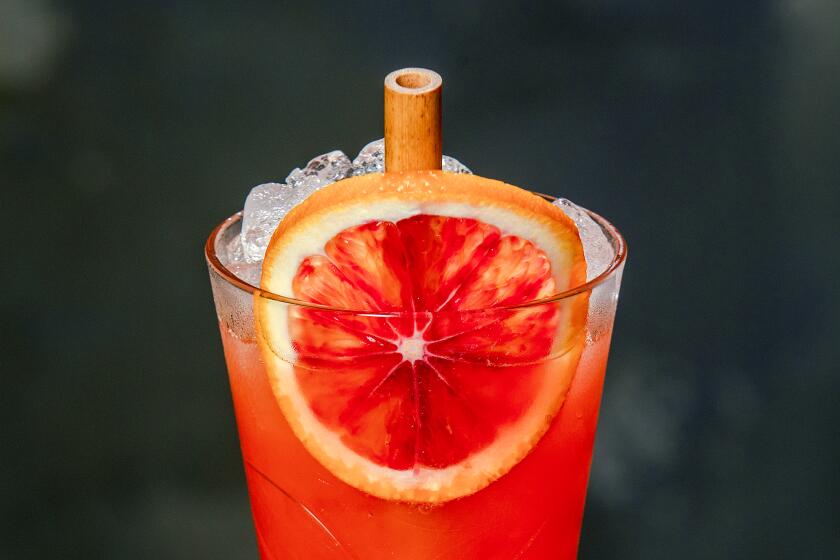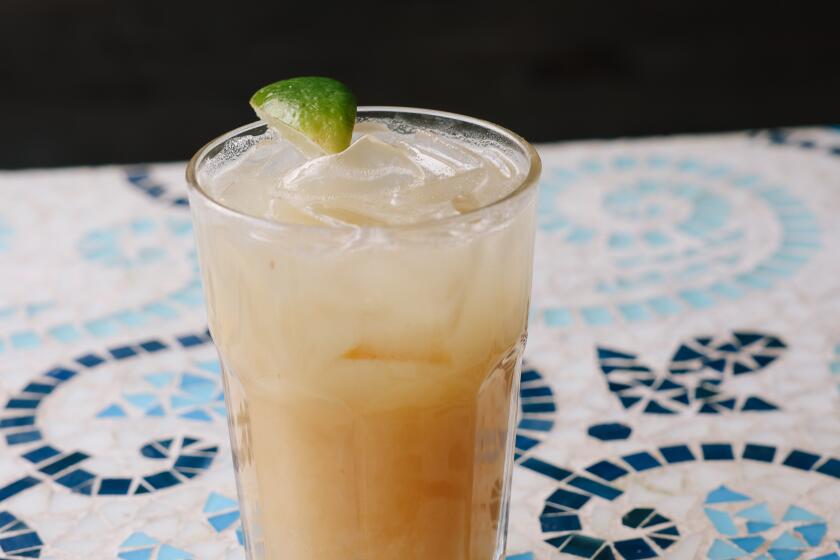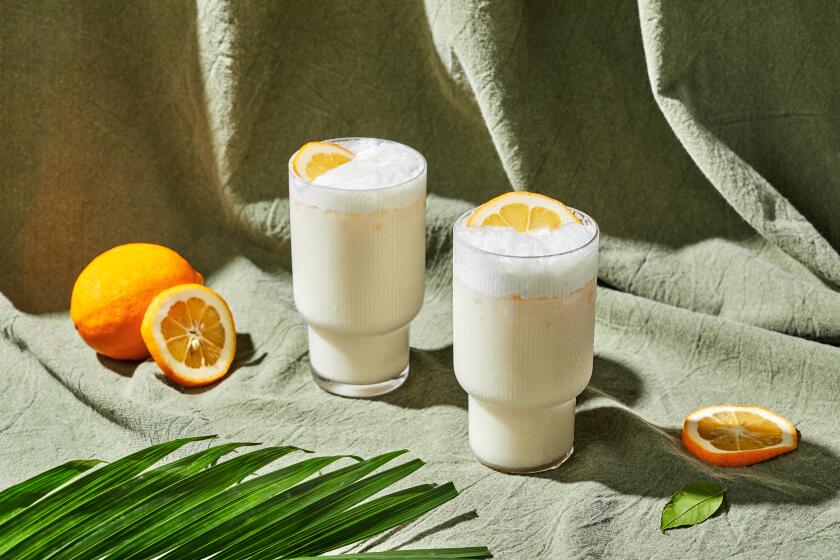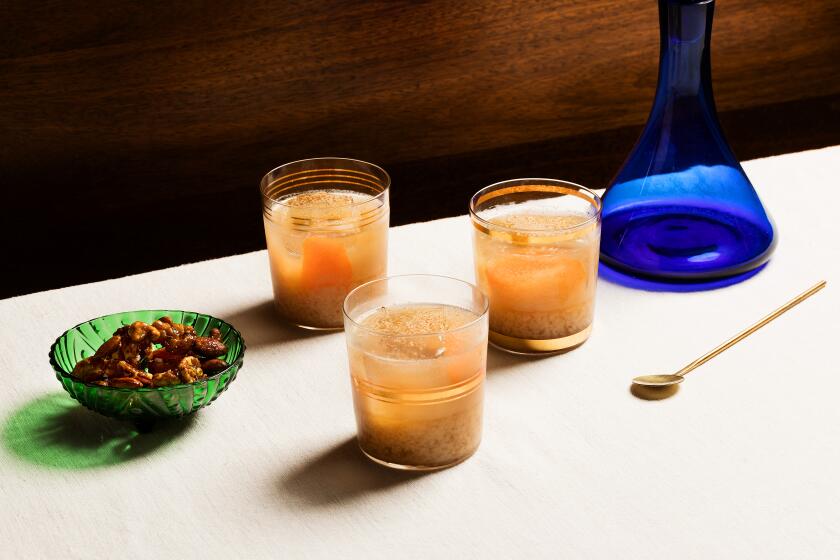The Lily Dew

Armed with a cocktail shaker and a dream, Marcos Tello is on a mission to elevate the profession of bartending.
A mixologist’s mixologist, he has helped bring together a community of Southern California bartenders and cocktail aficionados in a club called the Sporting Life, a monthly gathering that started last year with only eight people and has grown to more than 100, among them some of the region’s top barkeeps and most devout imbibers.
It’s a testament to L.A.’s growing drinks culture and a nascent society of like-minded bartenders who are reclaiming a craft.
“I’ve been working in L.A. for nearly 20 years,” said Jones bartender Eric Tecosky, “and there was never anything like this. It was more dog-eat-dog. [This is] a chance to exchange ideas, get exposed to new things. It’s hard to be part of a group like this and not want to be better.”
The Sporting Life -- whose members meet to trade cocktail arcana, catch up on bartender goings-on, conduct tastings, raise a glass to one another (and occasionally play flag football) -- is part of a trend happening across the country. In the last year, independent bartenders’ guilds and clubs -- bringing together craft-cocktail makers intent on educating themselves further in the bar arts -- also have sprung up in Seattle (Washington State Bartenders Guild); Portland, Ore. (the Oregon Bartenders Guild); Chicago (Third Coast Cocktail Club); and Washington, D.C. (D.C. Craft Bartenders Guild).
“We’re not quite at the stage of the pre-Prohibition era when bartenders were considered such an integral part of society or even as civic leaders,” said Keith Waldbauer, vice president of the Washington state guild, which started in September. “But you now can make a respectable career of it.”
The clubs’ pursuits include education and training, raising public awareness about the industry and community involvement. “One of our big things is to get enough members to get a group rate on health insurance,” said Jeffrey Morgenthaler, a founder of the Oregon guild. “This industry of ours doesn’t lend itself to professionalism. One of the reasons is there are never any benefits available.”
Bartenders in San Francisco and other cities have been actively involved in the U.S. Bartenders’ Guild, a 61-year-old organization that also has seen explosive growth. It now has 11 chapters (plus three more in the works) and 1,400 members, up from only three chapters and 120 members in 2005, said president Livio Lauro. “People are taking this job a lot more seriously.”
Tello, once a bartender at an Islands in Brea and now at the Varnish and Edison downtown, takes it seriously. In 2006, he attended a retreat led by cocktail guru Gary Reagan, followed by a four-day New York City pub crawl. “Everyone knew everyone, and it was such a tightknit community,” Tello said of New York’s bartenders. “I thought to myself, ‘I’m gonna go back [to California] and find this community.’
“I searched and searched and was crushed [not to find it]. I vowed to make it happen.”
He started e-mailing an earnest, info-packed “Sporting Life” newsletter to his peers that announced bartending events and competitions and featured bartenders about town (including himself on occasion), cocktail recipes, a “historical note of the month” (such as who first distilled the agave plant in 1521) and an invitation “to revolutionize the way the City of Angels approaches drinks.”
They always started the same way: “Hello. This is Marcos Tello and for those of you who don’t know me, I am a bartender. I wear that badge proudly. In an effort to bring honor back to my profession. . . . I am trying to unite bartenders in Los Angeles that are truly interested in the ‘craft of the cocktail.’ ”
In the jungle of the drinking world, Tello is sort of like an amicable, sane Fitzcarraldo, determined to carry the steamship of bartender-dom up an incline riddled with flavored syrups and oft-maligned vodka. (Instead of a linen suit and Panama hat, he wears suspenders and oxfords.)
That incline is far less steep than it was only a year ago. Just look at the list of bars and restaurants deemed “cocktail-friendly” in the newsletter; it has grown to 17 from four.
The first meeting, at which Tello provided sparkling-wine cocktails (“I didn’t even have glassware, just some cheap plastic flutes”), drew a meager crowd, but word spread and the club gained steam. “When Ted Haigh [drinks authority Dr. Cocktail] showed up at the second meeting, I thought, ‘Whoa!’ ” Tello said.
Liquor reps are allotted time at each meeting -- emceed by Tello -- to provide a brief educational presentation about their product. (Otherwise, liquor representatives who attend aren’t allowed to talk about what they’re shilling.) “We try to focus on smaller brands,” Tello said, “as opposed to the big liquor companies.”
The Sporting Life now is operated by a board formed in January -- dubbed the Los Angeles Cocktail Community Board -- that includes Tello as chairman and representatives of the local drinks demographic: a bar manager (Aidan Demarest of the Edison), a bartender (Jones’ Tecosky), a liquor rep, an enthusiast, a technician (who is working on the club’s coming website) and a writer (Chuck Taggart of is now responsible for the newsletter).
It’s not an exclusive club, but members are added to the list of newsletter recipients by informal referral.
Each Sporting Life meeting takes place at a different venue. July’s meeting was held at the Bazaar’s Bar Centro. “I definitely appreciate what Sporting Life is doing for Los Angeles -- let’s get people to stop drinking garbage,” Bryan Summers said from behind the bar, eliciting nods from his fellow barkeeps.
Now, a group of Sporting Life members -- Tello; Eric Alperin of the Varnish; Matty Eggleston, who is shaping the cocktail program at Wurstkuche downtown; and Liquid Architecture consultant Kim Haasarud -- is reviving the local chapter of the U.S. Bartenders’ Guild, organizing educational outings, tastings and seminars to create resources and a supportive environment for bartenders.
The move comes as the national guild refocuses on bartender education and launches its own certification program.
The Southern California chapter “had sort of languished,” said Eggleston, elected treasurer. “There wasn’t much going on, few competitions were being announced or organized. We were inheriting something we could refashion and were of a mind to put all of our efforts into it.”
Part of the reason for getting involved, Tello said, was that “we wanted to further educate bartenders and get them ready to be certified by the USBG and to help them find scholarships to attend the BAR” -- the Beverage Alcohol Resource program formed by cocktail authorities Dale DeGroff, David Wondrich and others (which bills itself as the mixology equivalent of the Masters of Wine).
Haasarud recently organized a Santa Monica farmers market expedition. Seminars include “taxes, contracts and consultation” and the ergonomics of shaking as well as a four-hour Scotch intensive.
“It’s good to bring in new blood,” said Naomi Filburn, a bartender at Hollywood Park for 24 years and a holdover Bartenders’ Guild member, who attended last month’s first USBG meeting at the Varnish under its new leadership (accompanied by her Pomeranian, Macho). “Hopefully, they’ll be able to get members willing to come out. Camaraderie is what brings the people. And drinks.”
In a mixing glass, stir together the sherry, vermouth, walnut liqueur, olive juice and bitters with cracked ice until well chilled. Strain and serve in a cocktail coupe with the orange twist.
Get our Cooking newsletter.
Your roundup of inspiring recipes and kitchen tricks.
You may occasionally receive promotional content from the Los Angeles Times.
















